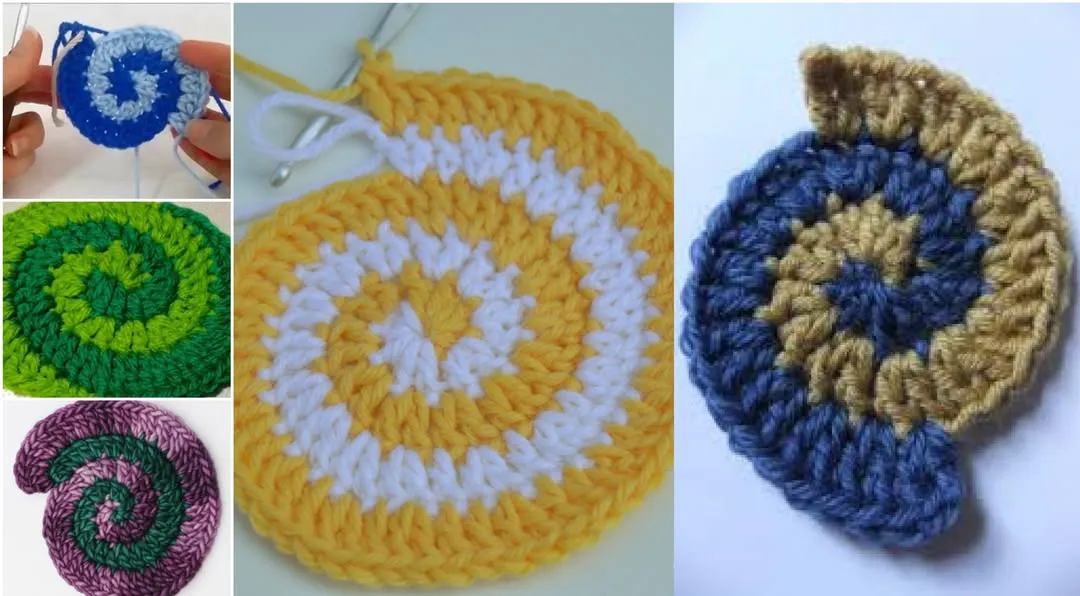
Learning how to crochet two color double spiral is an exciting and creative way to explore new dimensions in crochet design.
This technique allows you to combine two vibrant colors that twist and flow together in a mesmerizing spiral pattern, creating stunning coasters, mandalas, pot holders, and decorative pieces. The beauty of the two color double spiral lies in its symmetry, color contrast, and endless customization possibilities.
If you enjoy experimenting with yarn and want a project that’s visually captivating, then this method is perfect for you.

Unlike traditional flat crochet projects, the double spiral technique creates an illusion of movement and energy. Each round brings the colors to life as they swirl around one another without ever overlapping awkwardly.
You can achieve professional-looking results even if you are relatively new to crochet, as long as you understand the basic stitches and follow a few simple steps carefully.
The two color double spiral is worked in the round, and the pattern expands outward evenly. This makes it ideal for meditative crafting sessions—once you get the rhythm, it feels smooth and relaxing. Whether you’re making a colorful set of coasters, a vibrant wall hanging, or simply practicing your stitch consistency, this technique will elevate your crochet skills while keeping the process fun and inspiring.
To begin learning how to crochet two color double spiral, it’s important to understand what sets this design apart from other circular crochet methods. A typical spiral pattern uses one continuous color that builds upon itself in each round. However, in a double spiral, two colors are worked alternately, creating a perfectly balanced swirl that expands evenly in both tones.
When crocheting a two color double spiral, each color is worked independently, yet they intertwine beautifully without any seams or joins. The colors flow side by side, giving the illusion that they twist around each other in an endless motion. This is achieved by crocheting partial rounds with one color and then completing them with the second, ensuring each shade spirals smoothly into the next.
Another key aspect of the two color double spiral is that you don’t join rounds or chain up at the start of each new layer. Instead, you crochet continuously in a spiral, using stitch markers to help track where one round ends and another begins. This makes the finished work seamless and perfectly circular, free of jagged transitions or visible edges.
Crocheters love this method because it opens endless creative possibilities. You can use complementary colors for harmony, contrasting shades for boldness, or even gradient yarns to create an ombré effect. Once you understand the foundation, you can also expand the technique to three or more colors for even more complexity.
Before diving into the actual crochet process, it’s essential to gather the right tools and materials. Having everything prepared will make your project smoother and more enjoyable. To crochet a two color double spiral, you’ll need the following:
Once you have your materials ready, find a comfortable space with good lighting. Since this pattern involves alternating colors, it’s best to lay your yarn balls on opposite sides to prevent tangling. You’ll be switching between them frequently, so keeping them organized helps maintain a smooth rhythm.
Finally, remember that tension matters. Consistent tension ensures your spirals remain even and your circles lay flat. If your work starts curling, loosen your grip slightly or try a larger hook.
Now let’s break down how to crochet two color double spiral step by step. The process may seem complex at first, but once you complete the first few rounds, you’ll see how intuitive and fun it becomes.
Each round will expand the spiral further outward, creating that iconic two-tone swirl. When your piece reaches the desired size, simply slip stitch to finish both colors neatly, cut the yarn, and weave in your ends with a tapestry needle.
Now that you know how to crochet two color double spiral, it’s time to explore what you can make with this versatile pattern. This technique can be adapted for a variety of fun and functional projects.
The versatility of the two color double spiral ensures you can apply it to almost any project. Its dynamic appearance makes even the simplest designs look sophisticated.
To achieve the best results when learning how to crochet two color double spiral, keep these tips in mind:
With patience and a bit of practice, your spirals will become perfectly balanced and visually striking.
1. Is the two color double spiral suitable for beginners?
Yes, it’s beginner-friendly if you already know how to make basic stitches like single crochet and how to work in the round.
2. Do I need to use specific yarn types?
You can use any yarn you prefer. However, cotton yarn gives the best stitch definition for small projects.
3. How do I prevent my spiral from curling?
Maintain even tension, and increase stitches correctly each round. Blocking can also help flatten your piece.
4. Can I use more than two colors?
Absolutely! Once you master the two color version, you can experiment with three or more shades for a multi-colored spiral.
5. What hook size works best?
Follow the yarn label recommendation, but slightly larger hooks can make the fabric more flexible and easier to manage.
6. How do I join spirals together for larger projects?
Use slip stitches or whip stitching to connect your spirals neatly, making sure the color transitions align naturally.
Learning how to crochet two color double spiral is both rewarding and fun. It combines creativity, precision, and color harmony in one project. With simple materials and a bit of patience, you can create stunning spirals that stand out in any handmade collection.
Whether you’re crafting coasters, wall art, or practicing new crochet techniques, this pattern adds vibrancy and movement to your work.
Don’t forget to share your results, leave a sincere opinion, and offer suggestions for future crochet guides—your feedback helps inspire more creative tutorials for everyone who loves yarn and color.
